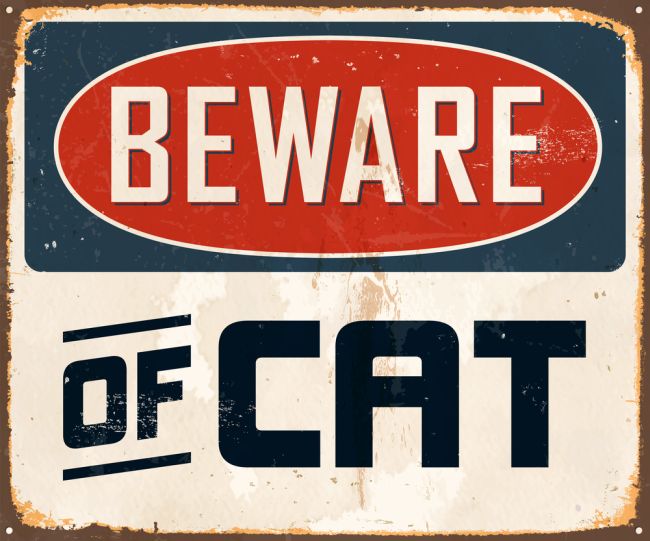 All experienced cat owners have a healthy appreciation for cat claws. Witnessing unfortunate couch cushions and curtains be shredded irreparably, or physically suffering through a random cat attack is enough to inspire even the most devoted cat-lover to give feline paws plenty of distance. Here are some of the reasons why cats scratch, and how to avoid being caught in the middle of a paw-flying flurry.
All experienced cat owners have a healthy appreciation for cat claws. Witnessing unfortunate couch cushions and curtains be shredded irreparably, or physically suffering through a random cat attack is enough to inspire even the most devoted cat-lover to give feline paws plenty of distance. Here are some of the reasons why cats scratch, and how to avoid being caught in the middle of a paw-flying flurry.
Felines scratch for many practical reasons. Scratching helps groom a cat’s claws by removing the dead layer on the outside of the talons. Cats scratch to stretch their paws, legs, toes, and spines, and also to make their territory. Felines have pheromone glands in their paws, therefore stretching and scratching on surfaces or fabrics leaves their odor behind. This helps a cat “make his mark” with the scratch marks and scent. However, cats also scratch as a defensive action, even attacking their owners in some cases. These are usually the causes of scratch-attacks:
Pain: When nursing a wound such as a cut or scrape, cats do not like to be touched, and may hiss or scratch if someone gets too close. (This can make bandaging a wound challenging; so we recommend putting on a calming collar or using some catnip to sooth the tension before taking the cat to the vet, or wrapping a cut.) Cats with diseases and internal pain might also behave aggressively, particularly if the sore area is approached.
Fear & Defense: When cats are suspicious, cornered, suddenly frightened they can behave defensively the only way they know how: hissing, scratching and biting. To avoid incensed kitty claws, help keep disturbances and disruptions to a minimum. This might include loud noises, threatening behaviors (such as chasing, raising arms, yelling, etc.), and allowing extremely sensitive cats their own space when strangers or other animals are present, etc.
Redirected: This kind of scratch occurs when a human tries to intercept a cat’s attack on something. This might be anything from a cat fighting off a dog, or squabbling with another cat, stalking prey, or if a cat is unexpectedly surrounded by unfamiliar animals, people, or loud noises. (If a cat sees an animal outside through a window that he wants to chase but can’t, sometime they will even will turn and attack whoever is closest to them.) These kind of scratch wounds can be the most dangerous because they are uninhibited defensive attacks. Be cautious (giving plenty of warning) when walking toward a cat by a window, and use a long item like a broom stick when trying to break up a cat fight.
Play & Petting: Most cats enjoy when their owners pet them. But when some motions become too forceful or repetitive, they can cause minor shocks of static electricity, or too much pressure or pain. A cat might at some point feel that he has had enough, and will give a little scratch to let you know it. Avoid this by being mindful while stroking your cat, changing the area, the pressure level from time to time.
The same sort of warning scratch can happen when playtime gets a little too rowdy. Scratching during a game often happens with kittens, or cats under a year old. How you play is also an important factor; if you are training your kitty to pounce or stalk your hand, expect an inadvertent scratch from time to time. Attacking a human during playtime his way is also considered part of the “predatory” motivation that leads to scratching. Instead of seeing someone as an authority figure, there is a sense of dominance that must happen, or a desire to chase, attack and catch the hand, foot, sock, etc. or whatever it may be. Start young and help your cat learn the proper boundaries of playtime.
Maternal/Possessive: Recent mother cats shift into a highly protective gear when they have just given birth. Pet owners should give their cat plenty of privacy, and move very slowly around a mother and her kindle. Likewise, when cats have to share the same space, litter boxes, toys and beds, etc., they can be possessive and scratch each other, or anyone that tries to get in the way.
Notorious Scratching Breeds
Every cat breed scratches, since it is a natural part of their survival. But this list below warns of the felines who are known for scratching or attacking their owners more often than typically docile breeds. Several of these kinds of cats are characterized as extremely friendly, so pet parents would be wise to understand their cat’s boundaries to avoid conflict. Be mindful when you play with felines, that old habits (and instincts!) die hard, and if things get a little heated, the kitty might take a swipe in your direction.
- Singapura
- Sphynx (only when highly provoked)
- Scottish Fold
- Siamese
- Egyptian Mau
- Cymric
- Bombay
- Bengal
- American Wirehair
*If you are looking for a no-fuss easy going cat, perhaps consider a breed that is often used in pet therapy.

